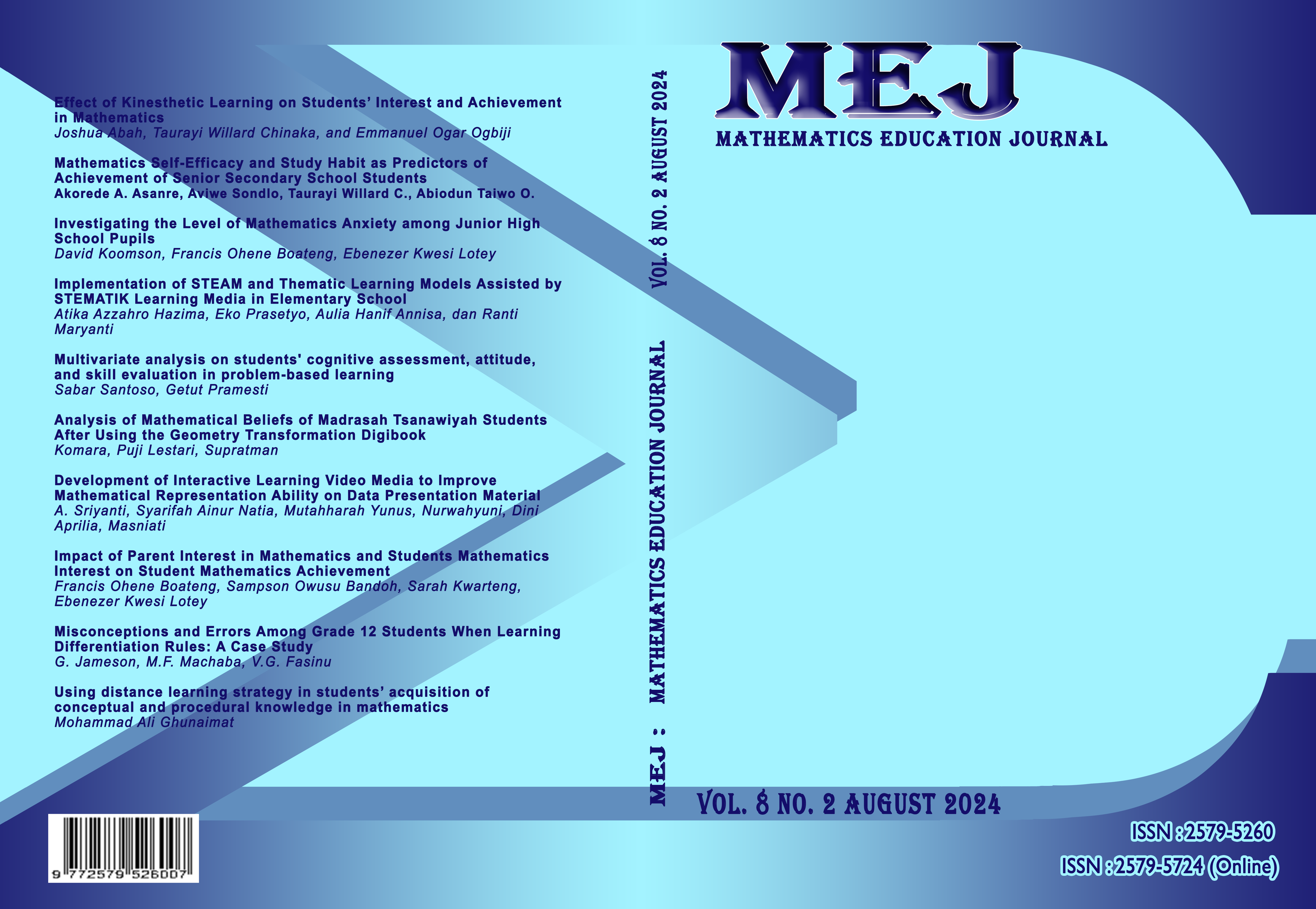Using distance learning strategy in students’ acquisition of conceptual and procedural knowledge in mathematics
DOI:
https://doi.org/10.22219/mej.v8i2.34823Abstract
The study investigates the effect of using Distance learning (DL) on students’ acquisition of conceptual and procedural knowledge in mathematics. The study used the quasi-experimental approach, where the study was applied by two groups of ninth grade students (experimental, 25 students, and control, 26 students), the experimental group was taught by using Distance learning, and the control group was taught in the usual way, after verifying the validity coefficients. And reliability for testing conceptual and procedural knowledge. The results demonstrated statistically significant differences favoring the experimental group, suggesting that Distance learning has a beneficial impact on mathematics instruction. The study included recommendations on the necessity of promoting Distance learning usage among students and teachers additionally the function of educational technology in the process of teaching and learning mathematics.
Downloads
References
Abri, A., Hamadi, M., Mazroui A., & Tashtoush, M. (2023). Distance Learning in Teaching Mathematics: Perspective and Challenges of Primary School Teacher. International Journal of Multidisciplinary Sciences and Arts, 2(1), 49–61.
Al-Halaibi. H. (2022). Using distance teaching in mathematics. Scientific Journal for Publishing Research, 9(1), 1–27.
Alrantisi, M. S. (2020). A survey of DL challenges in UNRWA schools in Gaza governorates in the light of COVID-19 pandemic from teachers’ perspectives: Obstacles to implementing distance education in UNRWA schools in Gaza governorates from the teachers’ perspective. Journal of Educational and Psychological Sciences, 4(38), 57–74.
Ben-Motreb. (2010). Preservice Primary Teachers’ Mathematics Conceptions and Practices. The University of Manchester.
Celen, Y. (2023). Misconceptions of 9th Grade Students about Numbers. The Turkish Online Journal of Educational Technology, 22(2), 25–33.
Chimmalee. B. (2023). The Effects of Using Flipped Cloud Learning with Advancing Mathematical Thinking Approaches on Undergraduate Students’ Mathematical Critical Thinking. Turkish Online Journal of Distance Education, 24(3), 1302–1433.
Georgiou, M. (2018). Issues that revolve around the concepts of distance education and e-learning. International Association for Development of the Information Society, 205–209.
Ghunaimat, M. (2020). The View of the Mathematics Teachers in the Basic Stage Towards the Problems of Using E-Learning in the Province Irbid – Jordan. Journal of Educational Sciences, 32(2), 321–344.
Ghunaimat, M., & M. E. (2022). The Viewpoint of Mathematics Teachers Towards DL in The Basic Stage in The Directorate of Education of The Taibah Districts in Irbid Governorate - Jordan. Journal of Educational Sciences, 20(20), 103–132. https://doi.org/10.29117/jes.2022.0090
Hamadenah, M. and A. (2017). Mathematics Teachers’ Attitudes in Jordan toward Using Social Media (Facebook) in Teaching Mathematics. Journal of Al-Quds Open University for Educational & Psychological Research & Studies, 5(18), 307–321.
Hiebert, J., & L. P. (1986). Conceptual and procedural knowledge in mathematics: An introductory analysis (1st ed.). Lawrence Erlbaum Associates.
Hwang, G., T. C., & Y. H. (2008). Criteria, strategies and research issues of context-aware ubiquitous learning. Educational Technology & Society, 11(2), 81–91.
Jelena, S., D. P., I. M., N. D., J. I., H. A., S. R., B. P., M. M. (2021). Application of distance learning in mathematics through adaptive neuro-fuzzy learning method, Computers & Electrical Engineering, 93(1).
Jordanian Ministry of Education. (2020). Your online lesson platform for distance.
Juwaida, A. T. and. A. A. A. (2019). Characteristics and objectives of DL and e-learning. Arab Journal of Arts and Human Studies, 6, 285–296.
Karatepe, F., K. N., & P. B. (2020). What are the perspectives of teacher candidates on synchronous distance education? A survey study. Journal of Social and Humanities Sciences Research, 7(53), 1262–1274.
Khashan, K. Q. R. A.-N. M. A.-S. M. (2012). Conceptual and Procedural Knowledge of Rational Numbers for Riyadh Elementary School Teachers. Journal of Education and Human Development, 26(2), 287–310.
National Council of Teachers of Mathematics. (2005). Principles and standards for school mathematics. NCTM.
Radhakrishnan, N. (2024). Unlocking Success: Transforming Challenges into Solutions in the World of Remote Learning and Online Teaching for Distance Education. Educational Administration: Theory and Practice, 30(4), 5649–4565.
Raewyn, E. P.-R. K. & H. A. (2023). Weaving mathematics education research from all perspectives. 45th Annual Conference of the Mathematics Education Research Group of Australasia.
Snoussi, T., R. A. (2020). Distance E-Learning (DEL) and Communication Studies During Covid-19 Pandemic. Utopía y Praxis Latinoamericana, 25(10), 1–12.
Szulc, J. (2020). Distance Learning – the Current Status and Directions for Further Research. International Journal of Research in E-Learning, 6(1), 1–19.
Volodymyr, K., I. B. (2024). Active Distance Learning for Tutors. Open Educational E-Environment of Modern University, 16, 64–75.
Williamson, R. & G. H. (2007). Learning and Teaching Virtual Learning Environments. Learning Matters Ltd.
Xianyang, L. (2024). The analysis of distance learning based on Vygotsky’s Learning Theory. SHS Web of Conferences 183.

Downloads
Published
Issue
Section
License
Copyright (c) 2024 mohammad Ali ghunaimat

This work is licensed under a Creative Commons Attribution-ShareAlike 4.0 International License.
Authors who publish with MEJ (Mathematics Education Journal) agree to the following terms:
For all articles published in MEJ, copyright is retained by the authors. Authors give permission to the publisher to announce the work with conditions. When the manuscript is accepted for publication, the authors agree to automatic transfer of the publishing right to the publisher.
Authors retain copyright and grant the journal right of first publication with the work simultaneously licensed under a Creative Commons Attribution-ShareAlike 4.0 International License that allows others to share the work with an acknowledgment of the work's authorship and initial publication in this journal.
Authors are able to enter into separate, additional contractual arrangements for the non-exclusive distribution of the journal's published version of the work (e.g., post it to an institutional repository or publish it in a book), with an acknowledgment of its initial publication in this journal.
Authors are permitted and encouraged to post their work online (e.g., in institutional repositories or on their website) prior to and during the submission process, as it can lead to productive exchanges, as well as earlier and greater citation of published work (See The Effect of Open Access).

This work is licensed under a Creative Commons Attribution-ShareAlike 4.0 International License.









